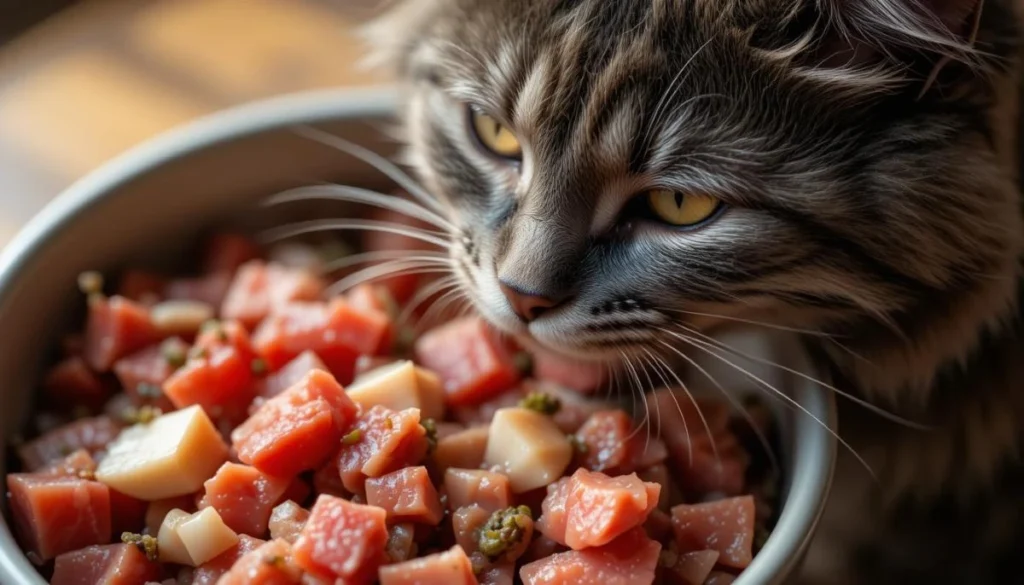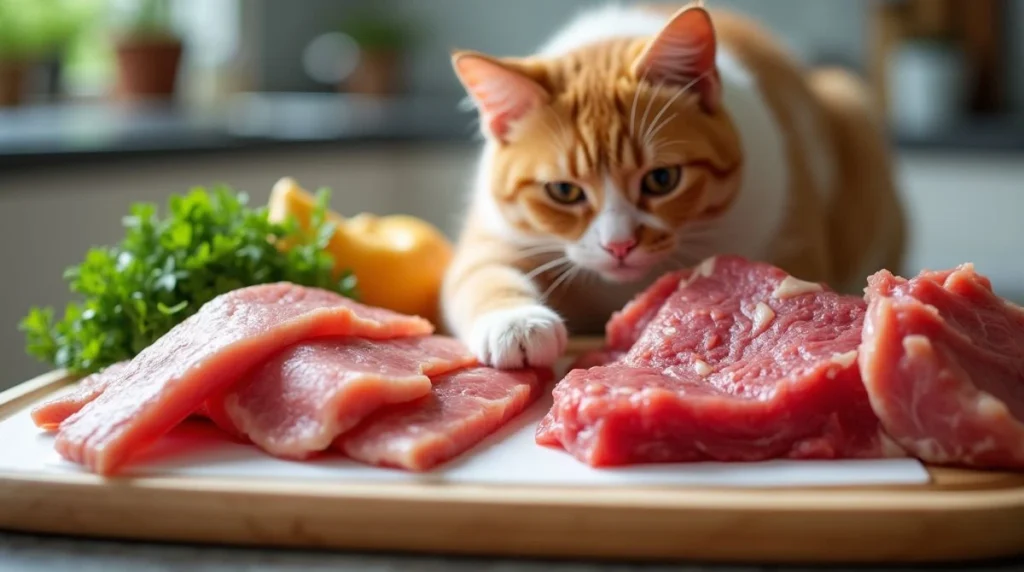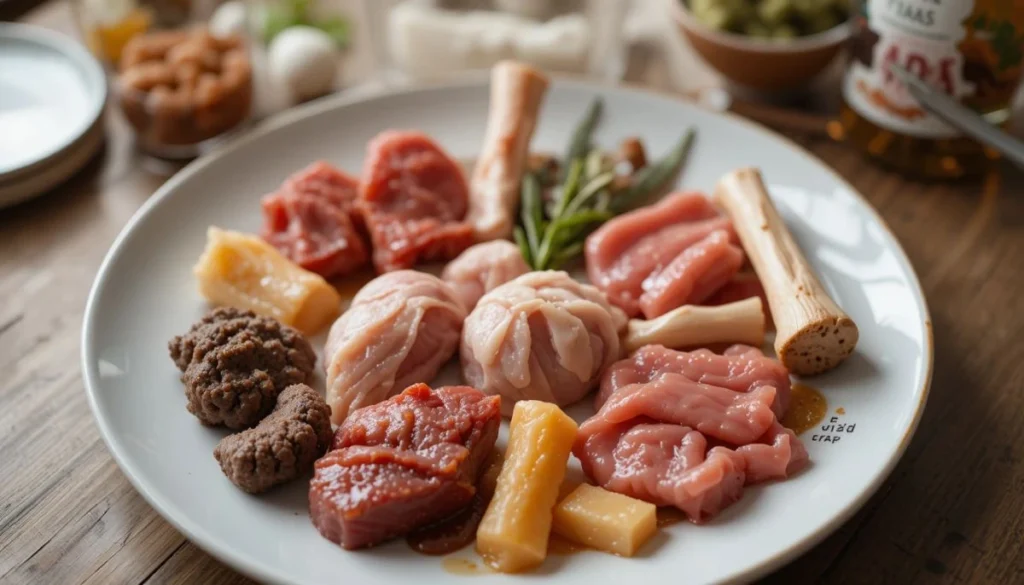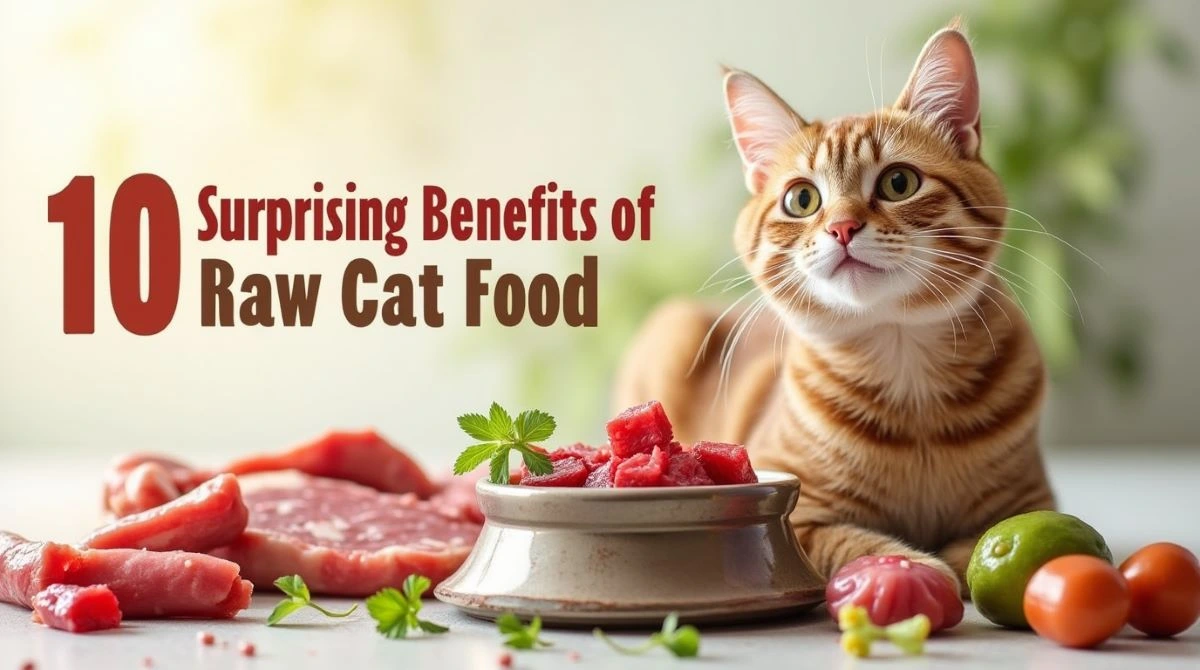Raw cat food has become a popular choice among pet owners looking to provide their feline friends with a more natural and nutrient-rich diet. Unlike traditional kibble or canned food, raw cat food mimics what cats would eat in the wild, offering a diet rich in raw meats, organs, and essential nutrients. Advocates for this approach claim that it can lead to numerous health benefits, including improved digestion, a shinier coat, and increased energy levels.
In this blog post, we’ll explore the surprising benefits of raw cat food, provide practical tips for safely transitioning your cat to this diet, and answer common questions to help you decide if raw feeding is the right choice for your furry companion. By the end, you’ll have a clear understanding of why raw cat food is gaining traction as a healthier and more natural alternative for cats.
Table of Contents
What Is Raw Cat Food and Why Is It Gaining Popularity?
Understanding Raw Cat Food: Definition and Basics
Raw cat food refers to a diet primarily composed of uncooked ingredients, such as raw meat, bones, and organs, designed to mimic the natural prey that cats would consume in the wild. This approach focuses on providing cats with high-quality, unprocessed ingredients that are rich in essential nutrients like protein, taurine, and fatty acids. Unlike traditional pet foods, which are often cooked and processed, raw cat food retains its natural nutritional profile without the use of preservatives, fillers, or artificial additives. By offering cats a diet that closely resembles their ancestral eating habits, raw feeding enthusiasts believe this diet helps optimize feline health and well-being.
The Rising Trend of Raw Feeding for Cats
In recent years, the popularity of raw cat food has soared as more pet owners embrace the idea of feeding their cats a species-appropriate diet. This trend is partly driven by growing awareness of the potential drawbacks of processed cat food, such as high carbohydrate content and questionable ingredients. With the rise of social media and online communities, raw feeding advocates have shared countless success stories, showcasing healthier, more energetic cats that thrive on a raw diet. Moreover, as people become more conscious of their own dietary choices, they are extending this focus on natural and wholesome eating to their pets, fueling the demand for raw cat food options.
Commercial vs. Homemade Raw Cat Food
Pet owners interested in raw feeding often face a key decision: should they prepare homemade raw cat food or purchase commercial raw cat food products? Homemade raw cat food allows greater control over the ingredients and ensures that the diet is tailored to a cat’s specific needs. However, it requires careful planning to ensure the meals are nutritionally balanced. On the other hand, commercial raw cat food, often available in frozen or freeze-dried formats, provides a convenient option for busy pet owners. These products are typically formulated by experts to meet the nutritional guidelines for cats, making them a safer and easier alternative for those new to raw feeding. Both approaches have their merits, and choosing the right option depends on factors like time, budget, and the owner’s experience with raw feeding.
Top Health Benefits of Feeding Raw Cat Food

Improved Digestion and Nutrient Absorption
Feeding raw cat food can significantly enhance your cat’s digestive health. Cats are obligate carnivores, meaning their bodies are naturally designed to process raw meat efficiently. Unlike heavily processed kibble, which often contains grains and fillers that can be difficult for cats to digest, raw cat food is free from unnecessary additives. This makes it easier for cats to break down and absorb the essential nutrients from their meals, resulting in fewer digestive issues such as bloating, diarrhea, or constipation. Many pet owners notice that their cats produce smaller, firmer, and less odorous stools when fed a raw diet, further highlighting the improved digestion.
Healthier Skin and Shinier Coat
One of the most noticeable benefits of feeding raw cat food is the improvement in your cat’s skin and coat health. Raw diets are rich in omega-3 and omega-6 fatty acids, which are essential for maintaining healthy skin and a glossy coat. Cats consuming processed diets often struggle with issues like dry skin, dandruff, and excessive shedding due to a lack of these nutrients. In contrast, raw food provides these fatty acids in their natural form, promoting hydration and reducing inflammation. Over time, this can result in a softer, shinier coat and fewer skin-related problems, leaving your feline looking and feeling their best.
Boosted Energy and Vitality
Raw cat food is packed with high-quality proteins and nutrients that help support your cat’s energy levels and overall vitality. When cats receive a diet that closely resembles what they would eat in the wild, their bodies are better equipped to maintain optimal health. Protein, a primary component of raw diets, provides the building blocks for strong muscles and sustained energy throughout the day. Many pet owners report that their cats become more active, playful, and alert after switching to a raw food diet. This boost in energy is especially beneficial for young or highly active cats, but even older cats can experience renewed vigor and enthusiasm with the right nutrition.
Is Raw Cat Food Safe for Your Cat?
Common Myths About Raw Feeding
Raw feeding has its fair share of myths, often causing hesitation among pet owners. One common misconception is that raw cat food inherently exposes cats to harmful bacteria, such as salmonella or E. coli. While these pathogens can exist in raw meat, it’s important to remember that cats have a highly acidic stomach environment designed to neutralize many of these threats. Another myth is that raw feeding is overly complicated or time-consuming. However, with proper research and preparation, feeding raw can become a straightforward and rewarding process. By understanding the realities of raw feeding, cat owners can make informed decisions without being deterred by misinformation.
Safety Tips for Handling Raw Cat Food
Ensuring the safety of raw cat food starts with proper handling and preparation. Always purchase fresh, high-quality meat from reputable sources, and store it in the refrigerator or freezer to prevent spoilage. When preparing meals, use clean utensils, cutting boards, and surfaces dedicated to raw food to avoid cross-contamination. Wash your hands thoroughly before and after handling raw ingredients, and ensure your cat’s feeding area is kept clean. Serving raw food in small, manageable portions can also help reduce waste and minimize the risk of foodborne illness. Following these simple practices can make raw feeding safe for both you and your feline companion.
Understanding Risks and How to Mitigate Them
While raw feeding offers numerous benefits, it’s essential to acknowledge the potential risks and take steps to mitigate them. One risk is the possibility of an unbalanced diet, which can lead to nutritional deficiencies or excesses. Consulting a veterinarian or feline nutritionist to formulate a balanced raw diet ensures your cat receives all the nutrients they need. Additionally, introducing raw food too quickly can cause digestive upset, so transitioning gradually is key. For added convenience and safety, many pet owners opt for commercial raw cat food products that meet established nutritional standards. By addressing these risks proactively, you can safely enjoy the advantages of raw feeding without compromising your cat’s health.

How to Transition Your Cat to a Raw Food Diet
Steps for a Smooth Transition
Transitioning your cat to a raw food diet requires patience and a step-by-step approach to ensure a positive experience. Start by introducing small amounts of raw food alongside your cat’s current diet, gradually increasing the proportion of raw food over the course of one to two weeks. Begin with easily digestible proteins, such as chicken or turkey, to help your cat adapt to the new texture and taste. Monitor their response during this period, and only move on to different protein sources once your cat shows comfort with the raw food. A gradual transition helps prevent digestive upset and increases your cat’s acceptance of their new diet.
Signs Your Cat Is Adapting Well
During the transition, it’s essential to observe signs that your cat is adapting well to the raw food diet. Healthy indicators include improved appetite, consistent energy levels, and normal stool quality. Many pet owners also notice benefits such as reduced shedding, a shinier coat, and smaller, less odorous litter box waste. If your cat shows any signs of distress, such as vomiting, diarrhea, or refusal to eat, take a step back and slow the transition process. Each cat is unique, and some may require more time to adjust to a raw diet than others. Positive signs show that your cat’s body is benefiting from the new, nutrient-rich meals.
Mistakes to Avoid When Switching Diets
To ensure a successful transition, avoid common mistakes that could hinder your efforts. One of the biggest errors is switching your cat’s diet too quickly, which can lead to digestive upset or rejection of the new food. Another mistake is failing to balance the raw diet properly; feeding only meat without including organs and bones can lead to nutritional deficiencies. It’s also important to avoid mixing raw food with kibble in the same meal, as these foods digest at different rates, potentially causing discomfort. Lastly, don’t force your cat to eat raw food—offering a gradual, stress-free introduction will encourage acceptance and reduce resistance.
Essential Tips for Preparing and Feeding Raw Cat Food

Ingredients to Include for a Balanced Raw Diet
A balanced raw diet is crucial for your cat’s health and should include a variety of ingredients to meet their nutritional needs. The foundation of the diet should consist of high-quality muscle meat, such as chicken, turkey, or beef, which provides essential protein. Incorporate organ meats, like liver and kidney, as they are rich in vitamins and minerals critical for your cat’s well-being. Don’t forget to include raw meaty bones, such as chicken wings or necks, which supply calcium and promote dental health. Supplement the diet with taurine, an essential amino acid that supports your cat’s heart and vision, and ensure that the overall composition includes the right balance of protein, fat, and minimal carbohydrates.
Preparing Raw Cat Food at Home
When preparing raw cat food at home, cleanliness and proper handling are key to ensuring safety. Use fresh, high-quality ingredients sourced from trusted suppliers, and store meat at the correct temperatures to avoid spoilage. Invest in a kitchen scale to accurately measure portions and ensure balanced meals. Grind bones if necessary to make them easier for your cat to consume, or use pre-ground mixes that already contain the right ratios of meat, bones, and organs. Add supplements, such as fish oil for omega-3 fatty acids or a commercial vitamin mix, to round out the diet. Preparing food in batches and freezing portions can save time and make feeding more convenient.
Pre-Packaged Raw Food Options for Convenience
For pet owners who may not have the time or expertise to prepare raw meals at home, pre-packaged raw cat food offers a convenient and safe alternative. These products are often available in frozen or freeze-dried formats and are formulated by experts to meet the nutritional requirements of cats. Look for reputable brands that use high-quality, natural ingredients without fillers or artificial additives. Many pre-packaged options come in portioned servings, making it easy to feed your cat the right amount without any guesswork. Be sure to follow the storage and serving instructions provided by the manufacturer to ensure the food remains fresh and safe for your cat.
Conclusion: Raw Cat Food
Raw cat food has emerged as a game-changing dietary choice for pet owners seeking to provide their feline companions with optimal nutrition. By mimicking a cat’s natural prey diet, raw food offers numerous benefits, including improved digestion, healthier skin and coat, increased energy, and overall enhanced well-being. While transitioning to raw feeding may require careful planning and a gradual approach, the rewards for your cat’s health and happiness are well worth the effort.
Safety and balance are essential when feeding raw cat food. Whether you choose to prepare meals at home or opt for pre-packaged options, ensuring your cat receives all the necessary nutrients is key to a successful diet. With proper handling and attention to your cat’s unique needs, raw feeding can become a sustainable and beneficial choice for your furry friend.
Ultimately, raw cat food isn’t just a trend—it’s a return to a more natural, species-appropriate way of nourishing your pet. If you’re ready to invest in your cat’s long-term health and vitality, transitioning to a raw diet might be the perfect step forward. Always consult with a veterinarian or feline nutritionist to ensure the best outcomes for your cat’s specific dietary needs.

